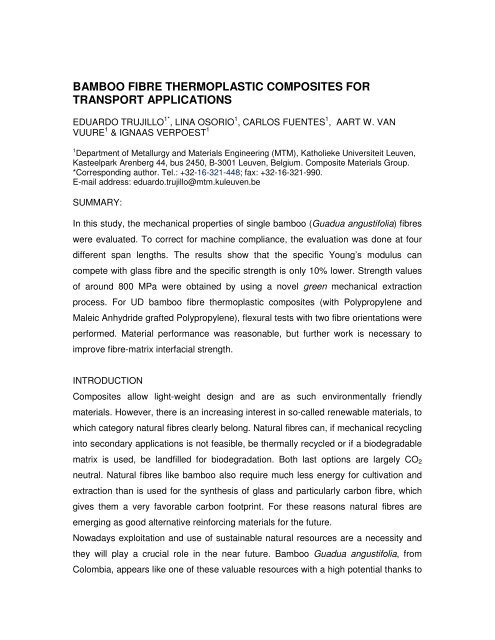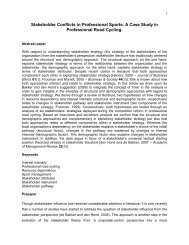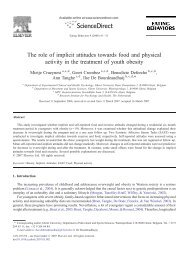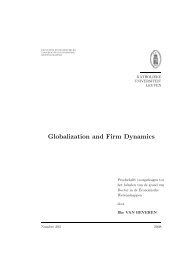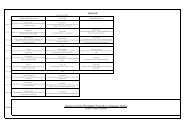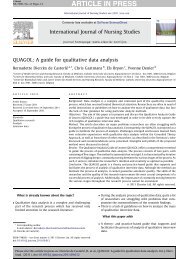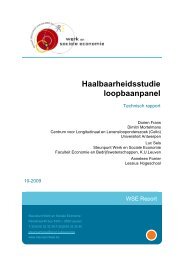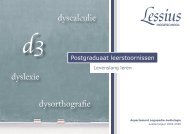bamboo fibre thermoplastic composites for transport applications
bamboo fibre thermoplastic composites for transport applications
bamboo fibre thermoplastic composites for transport applications
You also want an ePaper? Increase the reach of your titles
YUMPU automatically turns print PDFs into web optimized ePapers that Google loves.
BAMBOO FIBRE THERMOPLASTIC COMPOSITES FOR<br />
TRANSPORT APPLICATIONS<br />
EDUARDO TRUJILLO 1* , LINA OSORIO 1 , CARLOS FUENTES 1 , AART W. VAN<br />
VUURE 1 & IGNAAS VERPOEST 1<br />
1 Department of Metallurgy and Materials Engineering (MTM), Katholieke Universiteit Leuven,<br />
Kasteelpark Arenberg 44, bus 2450, B-3001 Leuven, Belgium. Composite Materials Group.<br />
*Corresponding author. Tel.: +32-16-321-448; fax: +32-16-321-990.<br />
E-mail address: eduardo.trujillo@mtm.kuleuven.be<br />
SUMMARY:<br />
In this study, the mechanical properties of single <strong>bamboo</strong> (Guadua angustifolia) <strong>fibre</strong>s<br />
were evaluated. To correct <strong>for</strong> machine compliance, the evaluation was done at four<br />
different span lengths. The results show that the specific Young’s modulus can<br />
compete with glass <strong>fibre</strong> and the specific strength is only 10% lower. Strength values<br />
of around 800 MPa were obtained by using a novel green mechanical extraction<br />
process. For UD <strong>bamboo</strong> <strong>fibre</strong> <strong>thermoplastic</strong> <strong>composites</strong> (with Polypropylene and<br />
Maleic Anhydride grafted Polypropylene), flexural tests with two <strong>fibre</strong> orientations were<br />
per<strong>for</strong>med. Material per<strong>for</strong>mance was reasonable, but further work is necessary to<br />
improve <strong>fibre</strong>-matrix interfacial strength.<br />
INTRODUCTION<br />
Composites allow light-weight design and are as such environmentally friendly<br />
materials. However, there is an increasing interest in so-called renewable materials, to<br />
which category natural <strong>fibre</strong>s clearly belong. Natural <strong>fibre</strong>s can, if mechanical recycling<br />
into secondary <strong>applications</strong> is not feasible, be thermally recycled or if a biodegradable<br />
matrix is used, be landfilled <strong>for</strong> biodegradation. Both last options are largely CO2<br />
neutral. Natural <strong>fibre</strong>s like <strong>bamboo</strong> also require much less energy <strong>for</strong> cultivation and<br />
extraction than is used <strong>for</strong> the synthesis of glass and particularly carbon <strong>fibre</strong>, which<br />
gives them a very favorable carbon footprint. For these reasons natural <strong>fibre</strong>s are<br />
emerging as good alternative rein<strong>for</strong>cing materials <strong>for</strong> the future.<br />
Nowadays exploitation and use of sustainable natural resources are a necessity and<br />
they will play a crucial role in the near future. Bamboo Guadua angustifolia, from<br />
Colombia, appears like one of these valuable resources with a high potential thanks to
its excellent mechanical properties and availability. The use of its <strong>fibre</strong>s has not been<br />
considered so often yet, particularly because of difficulties in extracting high quality,<br />
undamaged <strong>fibre</strong>s.<br />
MATERIALS AND METHODS<br />
Bamboo <strong>fibre</strong>s of the species Guadua angustifolia were obtained from well defined<br />
locations in Colombia. Technical <strong>fibre</strong>s (which will be referred to as <strong>fibre</strong>s in this<br />
paper), were extracted from the <strong>bamboo</strong> culms using a newly developed and<br />
proprietary extraction process, giving a maximum <strong>fibre</strong> length between 20 and 35 cm.<br />
Figure 1a shows a group of mechanically extracted <strong>fibre</strong>s whose diameter has a range<br />
between 90 and 250 µm; the main diameter concentration is around 150 µm. Be<strong>for</strong>e<br />
tensile testing, the <strong>fibre</strong>s were visually selected in order to verify the absence of<br />
defects along the length of the <strong>fibre</strong>s.<br />
a.<br />
Figure 1. a) Bamboo (Guadua angustifolia) technical <strong>fibre</strong>s after mechanical extraction and b)<br />
unidirectional <strong>bamboo</strong> <strong>fibre</strong> <strong>thermoplastic</strong> prepreg.<br />
After this, the cross sectional area of each individual <strong>fibre</strong> was determined using both<br />
the apparent density (1,44 gr/cm 3 according to ref. 1) and the weight as well as the<br />
length of the fiber. After this they were glued in between two paper frames to assure a<br />
good gripping and straight position in the test clamps. The opening of the paper frame<br />
determines the gauge length; <strong>for</strong> this experiment it was set at 5, 10, 25 and 40 mm.<br />
The single <strong>fibre</strong> tensile tests were per<strong>for</strong>med on a mini tensile testing machine with a<br />
loadcell of 200N where the crosshead speed was set at 1 mm/min; the load and the<br />
displacement are registered during the complete test. Because an extensometer<br />
cannot be used during the test, a theoretical correction <strong>for</strong> the machine compliance<br />
developed by Defoirdt, N., et al (ref. 2) was applied in order to determine the real<br />
elongation of the specimens. By plotting modulus versus 1/span, extrapolating to<br />
b.
1/span = 0 (infinite <strong>fibre</strong> length) provides the material modulus <strong>for</strong> which slip and<br />
machine compliance may be ignored. When thus the real material modulus is known,<br />
an estimation can be made <strong>for</strong> the machine compliance. Knowing this compliance,<br />
strain values can be corrected. The correction was done <strong>for</strong> every single experiment.<br />
Thermoplastic <strong>composites</strong> were prepared by compression moulding of stacks (7<br />
layers) of <strong>bamboo</strong> prepregs (see Fig. 1b), each consisting of untreated <strong>fibre</strong>s and two<br />
different <strong>thermoplastic</strong> films (Polypropylene and Maleic Anhydride grafted<br />
Polypropylene (MAPP)). To obtain good impregnation, the temperature used was<br />
about 25 degrees C higher than the melting temperature of the polymer and a<br />
pressure of 15 bars was used. In all cases, the natural <strong>fibre</strong>s and prepregs were dried<br />
overnight at 65°C to prevent problems due to moisture. Fibre volume fraction was set<br />
at 45% by weight measurements. Flexural strength and Young’s modulus <strong>for</strong> UD<br />
<strong>composites</strong> with longitudinal disposition of the <strong>fibre</strong>s were evaluated by 3 point<br />
bending tests on a universal testing machine (Instron 4426) based on ASTM D790M.<br />
Interface strength was determined from transverse bending strength according to the<br />
latter standard.<br />
RESULTS AND DISCUSSION<br />
Single Bamboo Fibre<br />
Single <strong>fibre</strong> tensile tests <strong>for</strong> untreated <strong>bamboo</strong> <strong>fibre</strong>s were per<strong>for</strong>med at different<br />
spans lengths. The values <strong>for</strong> tensile strength and Young’s modulus, after the<br />
machine compliance correction was applied (see above), are shown in Figure 2. Strain<br />
to failure remains around 1.9% on average. The modulus showed an extrapolated<br />
value of 43 GPa. Under tensile load <strong>bamboo</strong> <strong>fibre</strong>s show a clean fracture instead of<br />
defibrillation or splitting. The clean fracture shows that there is a good bond between<br />
the elementary <strong>fibre</strong>s and the technical <strong>fibre</strong> matrix (typically consisting of lignin; as is<br />
generally known, a vegetable <strong>fibre</strong> is in itself a composite). The small variation in<br />
tensile strength at different span lengths (Fig. 2) could be an indication of the low<br />
presence of defects along the length. This means that the mechanical extraction<br />
process that was applied in this case did not significantly affect the <strong>fibre</strong> quality. With a
density of <strong>bamboo</strong> <strong>fibre</strong> of 1.4, specific mechanical properties are very close to these<br />
of glass <strong>fibre</strong><br />
Figure 2. Tensile single <strong>fibre</strong> properties of <strong>bamboo</strong> <strong>fibre</strong>s (Guadua angustifolia), after machine<br />
compliance correction.<br />
Thermoplastic Bamboo Fibre Composites (BFC)<br />
For unidirectional <strong>bamboo</strong> <strong>fibre</strong> <strong>thermoplastic</strong> <strong>composites</strong> loaded in the longitudinal<br />
direction of the <strong>fibre</strong>s, it is marked that <strong>for</strong> both Polypropylene and MAPP the<br />
consolidation temperature has a clear effect on the final behaviour of the composite.<br />
Strength (MPa)<br />
Flexural strength <strong>for</strong> UD <strong>bamboo</strong> <strong>fibre</strong>/<strong>thermoplastic</strong> <strong>composites</strong><br />
220<br />
200<br />
180<br />
160<br />
140<br />
120<br />
100<br />
80<br />
60<br />
40<br />
20<br />
0<br />
Tensile Strength (MPa)<br />
1000<br />
900<br />
800<br />
700<br />
600<br />
500<br />
400<br />
300<br />
200<br />
100<br />
0<br />
Tensile properties of single <strong>bamboo</strong> <strong>fibre</strong>s<br />
5 10 25 40<br />
Gauge length (mm)<br />
0 0,5 1 1,5 2 2,5 3<br />
Strain at maximum strength (%)<br />
PP/BF 175°C<br />
PP/BF 185°C<br />
MAPP/BF 170°C<br />
MAPP/BF 180°c<br />
Figure 3. Stress strain behavior of <strong>bamboo</strong> <strong>fibre</strong> <strong>thermoplastic</strong> <strong>composites</strong>.<br />
For both cases, when the processing temperature is raised by 10 degrees C, the<br />
strength of the <strong>composites</strong> is shifted to the left part of the curve (see Fig. 3). There is<br />
no clear difference between PP and MAPP, as all samples are roughly situated on one<br />
50<br />
45<br />
40<br />
35<br />
30<br />
25<br />
20<br />
15<br />
10<br />
5<br />
0<br />
Young’s modulus (GPa)
line as a function of processing temperature. Also, the Young’s modulus <strong>for</strong> PP<br />
<strong>composites</strong> goes from 15.6 to 19.3 GPa and <strong>for</strong> MAPP <strong>composites</strong> from 11.8 to 16.4<br />
GPa, improving 24 and 39% respectively. This increase can be explained because the<br />
higher the temperature, the lower the viscosity of the polymer, so it will flow around the<br />
<strong>fibre</strong>s more easily. Young’s modulus is particularly indicative of the quality of<br />
impregnation. Theoretically, at 45% <strong>fibre</strong> volume fraction, one would expect a<br />
longitudinal modulus of about 20 GPa. Thus, it can be hypothesised that <strong>for</strong> PP at<br />
185°C (20° above the melting temperature), the wetting is probably quite good. The<br />
theoretical longitudinal strength is about 360 MPa. Whereas, <strong>for</strong> epoxy resins these<br />
strength values have been approached, <strong>for</strong> PP and MAPP the strength remains<br />
relatively low, indicating that probably significant improvements in interfacial bond<br />
strength are still possible and desirable.<br />
Transverse flexural strength BFC<br />
Table 1. Results <strong>for</strong> transverse flexural strength of <strong>bamboo</strong> <strong>fibre</strong>/<strong>thermoplastic</strong> <strong>composites</strong><br />
From transverse properties (Table 1), it is clear that even with an improvement in<br />
wetting (see above), the interface remains relatively weak, since the transverse<br />
strength values are lower than the strength values of the pure polymers. There is also<br />
very little difference between the results with PP and MAPP. We have indications that<br />
the surface of our <strong>bamboo</strong> <strong>fibre</strong>s is covered with lignin, which is apparently not highly<br />
compatible with either PP or MAPP.<br />
Consolidation temperature<br />
165 °C 170°C 175°C 180°C<br />
Polypropylene matrix (MPa) 17.3 ± 1.8 19.7 ± 0.5 18.6 ± 2.2 17.6 ± 1<br />
MAPP matrix (MPa) 16.1 ± 1.4 19.3 ± 0.8 18.7 ± 0.8 20.4 ± 0.3<br />
Flexural properties of <strong>bamboo</strong> <strong>fibre</strong> <strong>composites</strong> are compared with similar natural <strong>fibre</strong><br />
<strong>composites</strong> (Figure 4). This graph is included, just to give a rough idea of comparable<br />
systems, although <strong>fibre</strong> volume fractions vary strongly. It can e.g. be seen that in case<br />
of flax (with a flax <strong>fibre</strong> strength of about 700 MPa), good results have been obtained<br />
with MAPP (strength as anticipated higher than 200 MPa). We have seen in previous<br />
research that this situation is reverse <strong>for</strong> epoxy (<strong>bamboo</strong> composite strength<br />
significantly higher than flax composite strength). It seems clear that compatibility is
the key in these systems, to allow transfer of <strong>fibre</strong> properties into composite<br />
properties.<br />
Figure 4. Flexural properties <strong>for</strong> unidirectional natural <strong>fibre</strong>/<strong>thermoplastic</strong> <strong>composites</strong> (ref. 3-5)<br />
CONCLUSIONS<br />
Technical <strong>bamboo</strong> <strong>fibre</strong> is difficult to extract undamaged from the culm, but once a<br />
good extraction process is used, as developed at K.U.Leuven, <strong>fibre</strong>s are obtained with<br />
specific mechanical properties comparable to glass <strong>fibre</strong>. To reach the potential of<br />
<strong>bamboo</strong> <strong>fibre</strong> <strong>thermoplastic</strong> <strong>composites</strong>, further work is needed to improve the<br />
compatibility.<br />
ACKNOWLEDGEMENTS<br />
This research is sponsored by the Belgian Science Policy Office, in a cooperative<br />
project with Vietnam.<br />
REFERENCES<br />
Flexural strength (MPa)<br />
400<br />
350<br />
300<br />
250<br />
200<br />
150<br />
100<br />
50<br />
0<br />
Flax / PP (Vf: 18%)<br />
Flexural strength and flexural stiffness <strong>for</strong> UD natural<br />
<strong>fibre</strong>/<strong>thermoplastic</strong> <strong>composites</strong><br />
80<br />
Jute / PP (Vf: 50%)<br />
Flexural strength<br />
Flexural stiffness<br />
Jute / PP (Vf: 21%)<br />
Flax / PP (Vf: 27%)<br />
Flax / MAPP (Vf: 28%)<br />
Bamboo / PP (Vf: 45%)<br />
Flax / MAPP (Vf: 32%)<br />
Bamboo / MAPP (Vf: 45%)<br />
1) L. MORENO, L. OSORIO and E. TRUJILLO, Scientia et Technica 34 (2007), p. 613.<br />
2) N. DEFOIRDT et al, accepted paper to Composites, Part A (2010).<br />
3) O. KHONDKER et al, J. Polymers and the Environment 13 N° 2 (2005), p. 115.<br />
4) K. VAN DE VELDE and P. KIEKENS, J. Composite Structures 62 (2003), p. 443.<br />
5) O. KHONDKER, et al, Comp. Part A: App. Sci. and Manuf. 37 (2006), p. 2274.<br />
70<br />
60<br />
50<br />
40<br />
30<br />
20<br />
10<br />
0<br />
Flexural stiffness (GPa)


